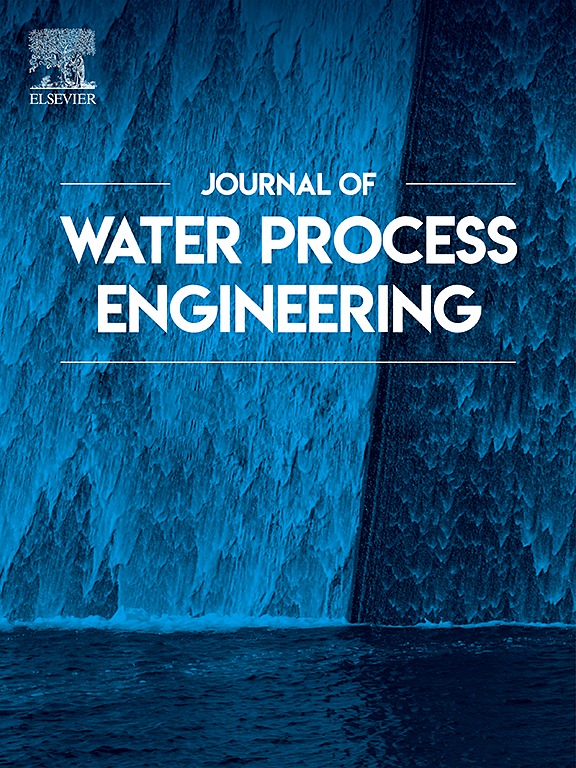Modeling and mechanistic understanding of vertical dissolved methane transport in integrated vertical flow constructed wetlands (IVCWs)
IF 6.3
2区 工程技术
Q1 ENGINEERING, CHEMICAL
引用次数: 0
Abstract
Constructed wetlands (CWs) are extensively utilized for rural domestic wastewater treatment, yet their role as sources of methane (CH4), a potent greenhouse gas (GHG), remains a critical environmental concern. While previous studies have quantified CH4 emissions from CWs, the vertical transport mechanisms governing dissolved methane (DCH4) dynamics within these systems are poorly understood. This study explores the vertical dynamics of DCH4 in integrated vertical flow constructed wetlands (IVCWs), focusing on environmental drivers and a newly proposed methane carbon pump model. Statistical analysis revealed a strong positive correlation between DCH4 concentration and sampling depth (Pearson's r = 0.703, P < 0.01), with concentrations at 1050 mm depth exceeding shallow layers (50 mm) by 51-fold. Structural equation modeling (SEM) further elucidated depth-dependent interactions, demonstrating that water temperature, dissolved oxygen (DO), and nutrient parameters (TC, TOC and TP) collectively explained 58 % of vertical DCH4 variability (R2 = 0.58). A mechanistic methane carbon pump model, integrating solute diffusion and root-mediated processes, achieved moderate predictive accuracy (R2 = 0.676) in quantifying vertical DCH4 transport. These findings underscore the pivotal role of vertical stratification in regulating CH4 dynamics, with depth-specific solute composition and redox gradients acting as key determinants. By resolving micro-scale transport mechanisms, this study advances the theoretical framework for modeling CH4 behavior in CWs, offering critical insights for future research on GHG mitigation in engineered wetland systems.
综合垂直流人工湿地溶解甲烷垂直输运模拟及机理研究
人工湿地(CWs)被广泛用于农村生活污水处理,但其作为甲烷(CH4)的来源,一种强效温室气体(GHG),仍然是一个关键的环境问题。虽然以前的研究已经量化了CWs的CH4排放,但对这些系统中控制溶解甲烷(DCH4)动力学的垂直输送机制知之甚少。本研究探讨了综合垂直流人工湿地(IVCWs)中DCH4的垂直动态,重点关注环境驱动因素和新提出的甲烷碳泵模型。统计分析显示DCH4浓度与采样深度呈正相关(Pearson’s r = 0.703, P <;0.01), 1050 mm深度的浓度超过浅层(50 mm) 51倍。结构方程模型(SEM)进一步阐明了深度依赖的相互作用,表明水温、溶解氧(DO)和营养参数(TC、TOC和TP)共同解释了58%的垂直DCH4变异(R2 = 0.58)。综合溶质扩散和根介导过程的甲烷碳泵模型在定量DCH4垂直输运方面具有中等的预测精度(R2 = 0.676)。这些发现强调了垂直分层在调节CH4动力学中的关键作用,深度特异性溶质组成和氧化还原梯度是关键决定因素。通过解决微观尺度的输运机制,本研究提出了模拟CWs中CH4行为的理论框架,为未来的工程湿地系统温室气体减排研究提供了重要见解。
本文章由计算机程序翻译,如有差异,请以英文原文为准。
求助全文
约1分钟内获得全文
求助全文
来源期刊

Journal of water process engineering
Biochemistry, Genetics and Molecular Biology-Biotechnology
CiteScore
10.70
自引率
8.60%
发文量
846
审稿时长
24 days
期刊介绍:
The Journal of Water Process Engineering aims to publish refereed, high-quality research papers with significant novelty and impact in all areas of the engineering of water and wastewater processing . Papers on advanced and novel treatment processes and technologies are particularly welcome. The Journal considers papers in areas such as nanotechnology and biotechnology applications in water, novel oxidation and separation processes, membrane processes (except those for desalination) , catalytic processes for the removal of water contaminants, sustainable processes, water reuse and recycling, water use and wastewater minimization, integrated/hybrid technology, process modeling of water treatment and novel treatment processes. Submissions on the subject of adsorbents, including standard measurements of adsorption kinetics and equilibrium will only be considered if there is a genuine case for novelty and contribution, for example highly novel, sustainable adsorbents and their use: papers on activated carbon-type materials derived from natural matter, or surfactant-modified clays and related minerals, would not fulfil this criterion. The Journal particularly welcomes contributions involving environmentally, economically and socially sustainable technology for water treatment, including those which are energy-efficient, with minimal or no chemical consumption, and capable of water recycling and reuse that minimizes the direct disposal of wastewater to the aquatic environment. Papers that describe novel ideas for solving issues related to water quality and availability are also welcome, as are those that show the transfer of techniques from other disciplines. The Journal will consider papers dealing with processes for various water matrices including drinking water (except desalination), domestic, urban and industrial wastewaters, in addition to their residues. It is expected that the journal will be of particular relevance to chemical and process engineers working in the field. The Journal welcomes Full Text papers, Short Communications, State-of-the-Art Reviews and Letters to Editors and Case Studies
 求助内容:
求助内容: 应助结果提醒方式:
应助结果提醒方式:


